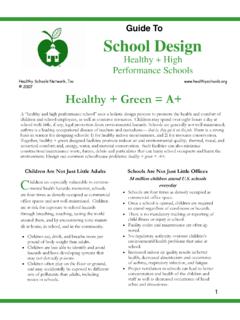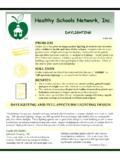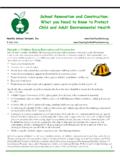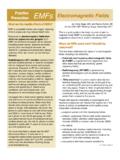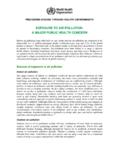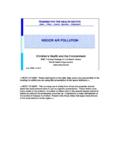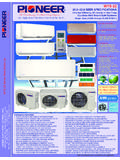Transcription of Molds at School - Healthy Schools Network
1 Molds at School Healthy Schools Network , Inc. 2002, 2012 The Basics About children Children may be at special risk from exposures to Molds at School . Young children's lungs and other or . gans are still developing and children can't identify hazards. They breathe more air per pound of body weight than adults do; they have hand to mouth behaviors; they rarely stop to wash their hands. While children are required to be in School , no laws protect children or even School personnel from exposure to Molds or specific levels of contamination. Schools are required to provide accessible facilities and pro . grams; children who are extremely mold sensitive or sensitive to other indoor air pollutants may be eli . gible for special accommodations.
2 Parents and personnel should be familiar with the symptoms and health effects of mold on children (see page 3) and monitor children's health. About School buildings Damp, moldy School environments are harmful to children for a variety of reasons. Damp indoor envi . ronments create conditions that are favorable for dust mites, and standing water in Schools can increase pest and rodent infestations, all of which can release allergens. Moisture also can cause building materi . als to off gas and release chemicals into the air, such as phthalates, a type of polyvinyl chloride (PVC), that can cause physical and mental health consequences. Damp environments may lead to growth of Molds indoors. Although some Molds are everywhere all the time, indoors and out, including in Schools , when wet conditions exist, Molds will grow to higher than normally occurring levels.
3 Federal studies have shown that many Schools are in poor repair and poorly maintained. Many Schools have plumbing problems, leaky roofs or poor ventilation systems, which can create ideal moisture conditions for Molds to grow. Moisture and mold problems can be present in Schools regardless of the climate or time of year, and may be present in older buildings as well as new construction. Delaying repairs or cutting back maintenance makes mold problems worse. Many Schools have mold problems because of poor construc . tion, or because they are tightly sealed and poorly ventilated, which prevents moisture from escaping. School personnel and parents should be alert to and help monitor Schools for moisture, water damage, and resulting mold problems.
4 (Sources: Institute of Medicine, Climate Change, the Indoor Environment, and Health; Collaborative on Health and the Environment, Learning and Developmental Disabilities Insti . tute) Testing buildings for mold is time consuming, expensive, and unreliable. No safe levels of Molds have been established. The most important actions to stop or prevent mold growth are: keep the building dry, stop leaks, get rid of mold contaminated items, fix sources of dampness and notify the School admini . stration when problems are not addressed. Molds will return when dampness returns. The time and money spent on testing can be better spent on cleanup and repairs. Indoor mold growth, mold con . taminated buildings, and especially mold contaminated Schools have been the topic of a growing number of news reports and health advisories.
5 The public health community and the general public are increasingly aware of the harmful health effects of mold growth indoors, and that Molds growing in Schools can be harmful to children's health and learning. 1. About Molds More than ugly, slimy nuisances, growing Molds can damage your health and your School . Unfortunately, inadequate maintenance will allow Molds to spread on ceilings, behind and on walls, on floors and car . pets, and in books and other water absorbing materials. Molds are a type of fungus. They eat or digest what they are growing on, and they grow colonies by producing long filaments of cells that form visible fuzzy or slimy patches. Molds reproduce by producing spores, tiny particles that can travel in the air and begin new colonies.
6 Molds need two things to live: materials to digest (such as food leftovers, wood, pa . per, cloth and wallboard) and moisture (such as water leaks, flooded carpets, wet basements, or very high humidity). If you see fuzzy, slimy, or discolored surfaces, especially in damp or wet areas, it's probably mold. Molds are often green, black, purple, or orange. An earthy or musty odor, or a smell like alcohol, is often a sign of hidden Molds . "Toxic" Molds Virtually all Molds have the potential to affect health, but some have received particular attention because they can release toxic substances called mycotoxins. These can cause health problems such as sinus inflammation, nose bleeds, and respiratory diseases, and can irritate existing asthma and allergies.
7 Further, some have neurotoxic, reproductive and carcinogenic properties. Molds can also create micro . bial volatile organic compounds (mVOCs), which can cause headaches, dizziness, nausea and other symptoms. There are many varieties of Molds and much more research is needed to fully understand the health effects of indoor mold exposure, however there are no safe Molds . Here are a few of the more common toxic varieties: Acremonium: can produce a substance that is toxic if consumed Alternaria: often found on carpets, textiles, and window frames in building interiors Aspergillis: several species produce mycotoxins, including Aspergillus flavus, found in water . damaged carpets and Aspergillus versicolor, found on damp wood or wallpaper glue Chaetomium: found on substances that contain cellulose (a plant material), such as paper, cardboard, soil, or compost; also often grows on carpet or between layers of wet plywood Cladosporium: often found inside supply ducts Fusarium: several Fusarium species produce mycotoxins; often found in humidifiers Paelimyces: often found in soil and dust, and sometimes in the air Penicillium: some species produce mycotoxins; often found in paint, compost piles, carpet, wallpaper, and interior fiberglass duct insulation.
8 Eg: Penicillium chrysogenum and Penicillium expansum Stachybotrys chartarum (Stachybotrys atra): the best known "toxic" mold, "stachy" is greenish . black and grows on materials that have high levels of the plant material cellulose and low levels of nitrogen, such as ceiling tiles, wood, and drywall Trichoderma: often found in paper, as well as unglazed ceramics; produces airborne toxins that are harmful to humans (Sources: Institute of Medicine, Damp Indoor Spaces; US Environmental Protection Agency, Mold Remediation in Schools and Commercial Buildings, Appendix B; American Industrial Hygiene Association, Facts About Mold; McNeel & Kreutzer. May/June 1996. Fungi & Indoor Air Quality. Health & Environment Digest, Vol 10, No 2.)
9 2. Molds at Home Molds can cause serious health problems, but it can be hard to establish a direct relationship between specific Molds and specific symptoms. Molds cause different reactions in different people. Students in one mold infested classroom could have varying symptoms some could become extremely ill, while others might have only mild, or even no, symptoms at present. To find out if Molds or other types of indoor pollutants are affecting your child's health, keep a daily log, note when symptoms appear, whether they are worse in certain locations or on certain days. Walk through the School and your house checking for mold or water damage. Tell your doctor. Common symptoms Include congestion, runny nose, coughing, and irritated eyes; new or worsening asthma; flu symptoms; headaches and, fatigue.
10 Less common symptoms include fever, vomiting, nausea, nosebleeds, dizziness, memory loss, diarrhea or constipation, and changes in behavior. Not everyone has the same symptoms, and some are not bothered at all. Other symptoms may be related to exposure to chemicals produced by Molds (including the volatile chemicals that cause moldy odors and chemicals known as mycotoxins), or fungicides and other chemicals applied to try to kill them. Some Molds can cause illness in exposed peo . ple whose immune systems are weakened by disease or drug treatments. Allergies and mold All Molds , dead or alive, can provoke allergic reactions in sensitive individuals. Research shows that people who live or work in very damp, moldy environments can become sensitized due to chronic exposures.
